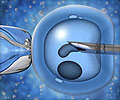A new study says that infants born from frozen embryos are likely to weigh more and do better than those born from fresh transfers.
Freezing embryos allows couples to have several cycles of IVF/ICSI from the same egg collection. The embryos are subsequently thawed and replaced three to five days after ovulation in exactly the same way as fresh embryos are used. The technique helps to reduce the number of times ovaries are stimulated and eggs collected.Scientists from Copenhagen University Hospital Rigshospitalet, Denmark examined 1267 children born between 1995 and 2006 after frozen embryo replacement (FER).
They were then divided into three groups with 878 born after cryo-preserved IVF, 310 after cryo-preserved ICSI and 79 where the method of creation of the embryos was unknown.
During the same period 17857 children were born after IVF/ICSI treatment using fresh embryos, and these children were used as controls. Data on the children's outcomes, including congenital malformations, were obtained from Danish national registries.
Maternal age was significantly higher in the FER group. Pregnancy duration was significantly longer for these mothers, and birth weight was also higher about 200 grams in the FER group. The proportion of low birth weight FER children significantly lower, as was the percentage of pre-term births.
"Additionally there were significantly fewer children admitted to a neonatal intensive care unit in the FER group although, when limited to single births, this difference disappeared," said Dr. Anja Pinborg, from the Copenhagen University Hospital Rigshospitalet, Copenhagen, Denmark.
Advertisement
"The findings are reassuring, although we still lack sub-analyses regarding malformations and neurological sequelae of the FER. But if our results continue to be positive, FER can be accepted as a completely safe procedure, which can be used even more frequently than it is currently," she added.
Advertisement
Source-ANI
RAS/S









